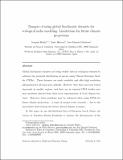Por favor, use este identificador para citar o enlazar a este item:
http://hdl.handle.net/10261/93832COMPARTIR / EXPORTAR:
 SHARE SHARE
 CORE
BASE CORE
BASE
|
|
| Visualizar otros formatos: MARC | Dublin Core | RDF | ORE | MODS | METS | DIDL | DATACITE | |

| Título: | Dangers of using global bioclimatic datasets for ecological niche modeling. Limitations for future climate projections |
Autor: | Herrera, Sixto CSIC ORCID CVN; Gutiérrez, José M. CSIC ORCID ; Bedia, Joaquín CSIC ORCID | Palabras clave: | Impacts of climate change Regional climate projection UAB Atlas WorldClim Species distribution models |
Fecha de publicación: | 2013 | Editor: | Elsevier | Citación: | Global and Planetary Change 107: 1-12 (2013) | Resumen: | Global bioclimatic datasets are being widely used in ecological research to estimate the potential distribution of species using Climate Envelope Models (CEMs). These datasets are easily available and offer high resolution information for all land areas globally. However, they have not been tested rigorously in smaller regions, and their use in regional CEM studies may pose problems derived from their poor representation of local climate features. Moreover, these problems may be enhanced when using CEMs for future climate projections-a topic of current active research-due to the uncertainty derived from the future altered climate scenarios.In this paper we use distributional data of European beech (Fagus sylvatica) in Northern Iberian Peninsula to analyze the discrepancies of the CEMs (predictive skill, variable importance and consistency using different predictor subsets) resulting from three alternative public, high-resolution climate datasets: a benchmarking regional climate dataset developed for the area of study (UC), the University of Barcelona Atlas for the Iberian Peninsula (UAB) and the worldwide WorldClim bioclimatic dataset (WC). The same CEM techniques (multiple logistic regression and multivariate adaptive regression splines) were applied to the different datasets, showing that the quality of the baseline climate has a great impact on the resulting models, as manifested by the different contributions of the bioclimatic predictors to the resulting models. Artifactual bioclimatic variables were found in some datasets, representing topographical features and spatial gradients, rather than true climatic patterns, thus significantly contributing to the models, although not for the right reasons. This causes a misleading model interpretation and problems for extrapolation in future climate conditions, as evidenced analyzing the future projections obtained using state-of-the-art regional climate projections from the ENSEMBLES project. © 2013 Elsevier B.V. | Versión del editor: | http://dx.doi.org/10.1016/j.gloplacha.2013.04.005 | URI: | http://hdl.handle.net/10261/93832 | DOI: | 10.1016/j.gloplacha.2013.04.005 | Identificadores: | doi: 10.1016/j.gloplacha.2013.04.005 issn: 0921-8181 |
| Aparece en las colecciones: | (IFCA) Artículos |
Ficheros en este ítem:
| Fichero | Descripción | Tamaño | Formato | |
|---|---|---|---|---|
| Dangers of using global.pdf | 7,08 MB | Adobe PDF |  Visualizar/Abrir |
CORE Recommender
SCOPUSTM
Citations
100
checked on 17-abr-2024
WEB OF SCIENCETM
Citations
90
checked on 23-feb-2024
Page view(s)
474
checked on 23-abr-2024
Download(s)
1.004
checked on 23-abr-2024
Google ScholarTM
Check
Altmetric
Altmetric
NOTA: Los ítems de Digital.CSIC están protegidos por copyright, con todos los derechos reservados, a menos que se indique lo contrario.
